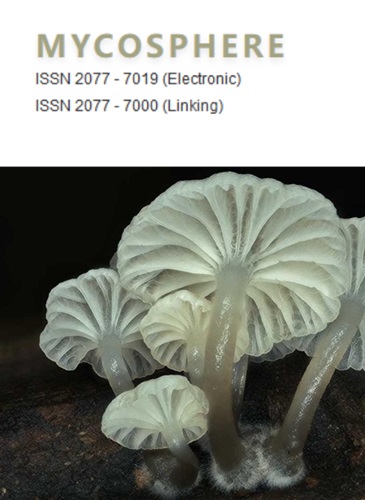Polyphyletic genera in Xylariaceae (Xylariales): Neoxylaria gen. nov. and Stilbohypoxylon
IF 15.1
1区 生物学
Q1 MYCOLOGY
引用次数: 15
Abstract
Several genera in Xylariaceae are polyphyletic in phylogenetic trees and represent more than one distinct genus. However, it is challenging to resolve these genera that are often phylogenetically distantly related, because many taxa have never been recollected and sequenced. Those that have been named and sequenced often lack documented characters or herbarium material. In this paper, we use descriptive morphology of fresh collections, and molecular data to resolve some taxonomic problems in Xylariaceae. During the of microfungi on palms in Thailand, we collected several novel xylariaceous taxa. Herein, we introduce a new genus Neoxylaria which is distantly related to Xylaria sensu stricto and a new species Stilbohypoxylon elaeidis. Neoxylaria is characterized by relatively small stromata with conspicuously exposed perithecial contours under a narrowly striped outer layer. Neoxylaria accommodates a species morphologically similar to Xylaria juruensis, which was also collected from palm material in Brazil and X. queenslandica collected from Archontophoenix alexandrae in Australia. As no molecular data exists for these old collections, we have linked them with morphology to our fresh collection and use both molecular data and morphology to introduce the new genus. Neoxylaria juruensis (Henn.) Konta & K.D. Hyde, comb. nov. and N. queenslandica (Joanne E. Taylor, K.D. Hyde & E.B.G. Jones) Konta & K.D. Hyde, comb. nov. are therefore established. Multigene phylogenetic analysis shows that our new species (S. elaeidis) clusters with Stilbohypoxylon sensu stricto (Stilbohypoxylon clade II) and Mycosphere 11(1): 2629–2651 (2020) www.mycosphere.org ISSN 2077 7019木木林科多系属:新木木林(Neoxylaria gen. 11 .)和Stilbohypoxylon
木木科的几个属在系统发育树上是多系的,代表一个以上的不同属。然而,由于许多分类群从未被收集和测序,因此解决这些通常在系统发育上有远亲关系的属是具有挑战性的。那些已经命名和排序的植物往往缺乏文献记载的特征或植物标本室材料。本文利用木木科植物新鲜标本的描述形态和分子数据来解决木木科植物的一些分类问题。在对泰国棕榈微真菌的调查中,我们收集到了几个新的木木科分类群。本文介绍了木蝇(Xylaria Neoxylaria)一新属和木蝇(Stilbohypoxylon elaeidis)一新种的远亲。其特征是相对较小的间质,在窄条纹的外层下明显暴露周轮廓。Neoxylaria有一种形态相似的Xylaria juruensis,也来自巴西的棕榈材料和澳大利亚的alexandrae Archontophoenix的X. queenslandica。由于没有这些旧集合的分子数据存在,我们将它们与形态学联系起来,并使用分子数据和形态学来介绍新属。河南新蝇(Neoxylaria juruensis)Konta & K.D. Hyde,梳子。11月和昆士兰北部(Joanne E. Taylor, K.D. Hyde和E.B.G. Jones)康塔和K.D. Hyde,梳子。11月因此成立。多基因系统发育分析表明,该新种(S. elaeidis)与Stilbohypoxylon sensu stricto (Stilbohypoxylon clade II)和Mycosphere 11(1): 2629-2651 (2020) www.mycosphere.org ISSN 2077 7019
本文章由计算机程序翻译,如有差异,请以英文原文为准。
求助全文
约1分钟内获得全文
求助全文
来源期刊

Mycosphere
MYCOLOGY-
CiteScore
30.00
自引率
8.20%
发文量
9
审稿时长
4 weeks
期刊介绍:
Mycosphere stands as an international, peer-reviewed journal committed to the rapid dissemination of high-quality papers on fungal biology. Embracing an open-access approach, Mycosphere serves as a dedicated platform for the mycology community, ensuring swift publication of their valuable contributions. All submitted manuscripts undergo a thorough peer-review process before acceptance, with authors retaining copyright.
Key highlights of Mycosphere's publication include:
- Peer-reviewed manuscripts and monographs
- Open access, fostering accessibility and dissemination of knowledge
- Swift turnaround, facilitating timely sharing of research findings
- For information regarding open access charges, refer to the instructions for authors
- Special volumes, offering a platform for thematic collections and focused contributions.
Mycosphere is dedicated to promoting the accessibility and advancement of fungal biology through its inclusive and efficient publishing process.
 求助内容:
求助内容: 应助结果提醒方式:
应助结果提醒方式:


